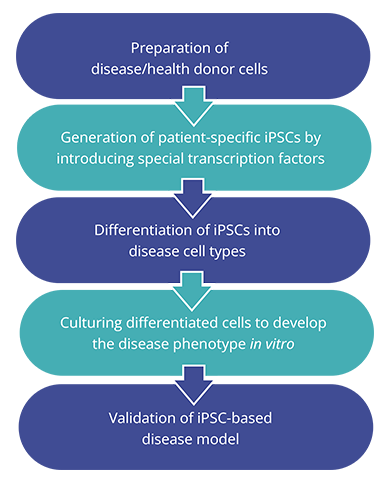Although many types of disease models such as immortalized cell systems have been developed, it is challenging to design disease models that involve multiple genes and mimic in vivo human disease state during disease research. iPSCs (induced pluripotent stem cells) that can differentiate into any cell type have emerged as an effective platform for the construction of disease models. iPSC-based disease models have been used for studying the pathological mechanism of disease and discovering novel therapies. Compared to animal models and immortalized cell systems, iPSC-based disease models offer patient-specific scalable biologic material of various tissue types and a complicated genetic signature of human tissue.
iPSC-based disease modeling begins with the generation of iPSCs from somatic cells (such as fibroblast, blood mononuclear cells, or urine cells from a patient or a healthy individual). These iPSCs can be differentiated using defined culture conditions to disease-relevant cell types. In general, the construction of disease models based on IPSC often involves multiple steps, each optimized for a specific disease and cell type.

Cas protein-based gene-editing technology has been widely applied for the construction of iPSC-based human disease models for both monogenic and complex genetic disorders. Using Cas protein-based gene editing technology, health iPSCs can be reprogrammed into patient-specific iPSCs, which can then differentiate into different cell types by introducing certain transcription factors. The main advantage of the IPSC-based human disease model is that it does not rely on the tissues from diseased individuals.
Somatic cell reprogramming methods is based on the forced expression of reprogramming factors in the cells to be reprogrammed. Many transcription factors have been identified to induce the generation of iPSCs from many types of somatic cells. For example, mouse skin fibroblasts can be reprogrammed into iPSCs by the introduction of specific gene combination. Currently, several methods have been used to introduce reprogramming factors into non-pluripotent cells, such as plasmids, direct transfection with reprogramming mRNA, miRNA, or protein, transposition system, and retroviral vectors. Among these, retroviral vectors are the most effective and widely used methods. However, delivery reprogramming factors via a retroviral vector may increase the risk of virus-induced tumor formation.
iPSC-based disease models enable scientists to study a range of human diseases in the laboratory, overcoming many of the challenges of achieving donor tissue from patients. Creative Biolabs provides a series of high-quality services for the construction of iPSC-based disease models, which are contributed to a better understanding of underlying biological mechanisms of human diseases and discovering novel therapies. If are interested in our iPSC-related services, please contact us for more details.
For Research Use Only. Not For Clinical Use.